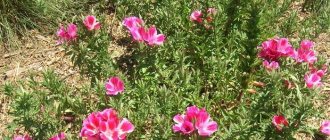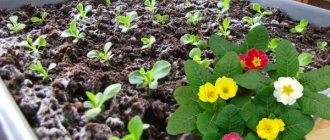It is difficult to find more watercolor, extraordinary, talented and hardy perennials than lupins. This plant has its disadvantages, but there are many more advantages. Lupines are good in natural design, and in modern styles, and even in classic regular gardens. They are colorful and versatile. But their main talent is their ease of cultivation. And although lupins are very easy to obtain vegetatively, the most economical way today remains their cultivation from seeds. Especially the seed method will please those who love the effect of unpredictability and surprises.
Seedlings of blooming lupines
Description of lupine
Representatives of the genus Lupinus are amazingly diverse plants. Wild, natural species of these plants seem pretty and landscape, but nothing more. And the best hybrids and varieties boast such beautiful flowering that they can outshine any much more popular perennial.
Lupines are truly unique plants. Powerful rhizomatous herbaceous perennials with amazingly beautiful leaves - palmate, on long petioles, exemplary graceful, they form elegant and interestingly textured bushes, from which they exude coolness and splendor, thanks to the dense arrangement of greenery and the bluish-cold tint of color.
But lupine always surprises not with its foliage, but with its flowering. Exemplary watercolor - there is no other way to describe it. Tall brush-shaped candles with delicate watercolor and pastel tones of pink, blue, lilac, lilac, cream, red, purple, and blue are in amazing harmony with each other and create in the plantings a feeling of blurred colors that flow into one another, similar to the works of watercolorists.
After flowering, lupins produce original bean fruits. Some types of lupins have larger seeds (only a few dozen seeds per 1 g), while others have small ones (up to 200 per 1 g). They ripen well even in regions with harsh winters, but they wake up very easily.
The seed propagation method is the main one for all annual and non-winter-hardy North American lupins and the second most important propagation method for perennial winter-hardy species and varieties. This status is explained simply: when grown from seeds, lupins are far from guaranteed to retain their coloring characteristics and improved flowering characteristics (which, if especially valuable varieties are preserved, can lead to their loss).
But this feature in other cases can also serve as an advantage: lupins always add an effect of improvisation, naturalness and even wildness to plantings. Subtle changes in shades or completely unexpected colors always give a feeling of novelty and magic, relieve boredom and predictability, and give new sensations.
Lupine seeds in pods
Lupins – reviews, impressions, recommendations
I dug up all the lupins, beautiful of course, but too aggressive - the seeds shoot out in all directions, the root grows underground so that to remove it you have to disturb the neighboring plants, or, in other words, dig it up, otherwise the root cannot be removed.
Brunette
https://www.forumhouse.ru/threads/86901/page-4
And last year these flowers bloomed until November. Despite the fact that Siberia. I like them very much. This year I will sow white ones at home, as well as red and yellow ones - I really like them. And so that they don’t grow where they shouldn’t, I just cut off the faded flowers and that’s it. But I have a small row allocated for them, so they won’t run around too much.
Lanka2005
https://www.forumhouse.ru/threads/86901/page-4
in the 70s, some “smart guy” from the Ministry of Agriculture ordered to sow lupine to enrich the soil with nitrogen, and everything would be fine, but..... livestock does not eat it, moreover, it is poisonous to livestock! It is almost impossible to remove it, because... there are a lot of empty lands, from there it goes further and further, so they told me in the village. So the blue flowering sea is a grief for the village.
Andrevna
https://dacha.wcb.ru/index.php?showtopic=10155
In the 70s, those “Clever Guys” did not understand the nature of lupins. There are perennials and there are annuals. If annuals are mowed during the flowering period, then they will fulfill their task as green manure and will not grow the next year. As for their toxicity, there are ordinary varieties, and there are ALKALOID varieties. Their cattle don’t eat, they make them feel bad. I myself saw how my grandmother’s cows in the village ate the usual - and nothing. Because it was NOT ALKALOID. But alkaloid ones are the best green manures, they protect the soil from harmful little things (all kinds of nematodes, phyto..., and even from such large things as the larva of the May beetle, wireworm and others... There is only one drawback - they grow for quite a long time to technical maturity. More than two months .
Faddeich
https://dacha.wcb.ru/index.php?showtopic=10155
Lupines are wonderful. Many consider them to be a weed that infests the garden with self-sowing plants, and therefore not worthy of attention. I tried to persuade my friend to plant them for several years. After the first flowering, she said she changed her mind about them. In the Moscow region, for example, they bloom precisely when there are few flowering plants at all - spring ones have already bloomed, but summer ones have not yet bloomed. They decorate the garden very much. Moreover, there are many very beautiful varieties.
Lena I
https://forum.bestflowers.ru/t/ljupin.146004/
As children we loved to sprinkle lupine flowers on each other. For this purpose, they specially went to the fields to collect flowers. Then there was no such riot of colors, everything was blue, blue ones were rarely found, and white ones were generally considered a “shortage”. It was interesting. You run home with a full bucket of flowers, and even drag an armful of branches for a bouquet.
Lika Mozyrko
https://xn--80avnr.xn--p1ai/%D0%96%D0%B8%D0%B2%D0%BE%D1%82%D0%BD%D1%8B%D0%B5_%D0%B8_ %D1%80%D0%B0%D1%81%D1%82%D0%B5%D0%BD%D0%B8%D1%8F/%D0%9B%D1%8E%D0%BF%D0%B8% D0%BD
It grows in several places in my summer cottage, because it is a leguminous plant that provides the earth with nitrogen, and also has different colors: yellow, red, purple, and white. Excellent green manure. I like that it is a perennial crop, unpretentious - it does not require special care, and is drought-resistant. Its complex palmate leaves on long petioles are amazing. After the rain, droplets roll beautifully on them. The flowering is charming and long lasting. It grows quickly.
Anna Zakharchuk
https://xn--80avnr.xn--p1ai/%D0%96%D0%B8%D0%B2%D0%BE%D1%82%D0%BD%D1%8B%D0%B5_%D0%B8_ %D1%80%D0%B0%D1%81%D1%82%D0%B5%D0%BD%D0%B8%D1%8F/%D0%9B%D1%8E%D0%BF%D0%B8% D0%BD
I love these flowers on a genetic level. The flowers and lacy foliage are beautiful. There are no problems with it at all, but if you trim the faded flowers in time. then flowering repeats again. For the winter I always prune and lightly hill up. I replant and divide in the spring. It can also be propagated by seeds, in which case it will bloom the next year.
Galchenok
https://forum-flower.ru/showthread.php?t=937
I have had red lupine growing for a long time. A neighbor asked for seeds. When they matured, I gave everything to her! She sowed everything. But then there wasn’t a single red one among the seedlings!
amplex
https://forum.prihoz.ru/viewtopic.php?f=36&t=1986&sid=1a96254db046a888b6843246a3a5a3ed&start=165
You need to keep an eye on him and keep an eye on him; if you miss him a little, everything around him will be “stained”, and it’s a little difficult to get him out. At a ripe flower, the pods open, curling up into a spiral and scattering seeds with a radius of up to 25 meters. So take this feature into account.
Petrovich2
https://dv0r.ru/forum/index.php?prev_next=next&topic=11074.0
Independent collection of lupine seeds and their selection for sowing
Lupine seeds remain viable for up to 5-6 years. It is preferable to use freshly collected seeds, but even after several years of storage they will germinate well. Moreover, this perennial prefers pre-treatment of seeds before sowing, which significantly increases the germination rate.
If you want to collect lupine seeds yourself, you should carefully monitor the ripening of the fruits. Lupine beans crack quickly. Therefore, it is better not to miss the moment when they evenly turn yellow and dry out slightly. You can also use the tying method. Lupine fruits are usually cut in several stages.
When purchasing seeds, carefully check the information about the variety and its characteristics - plant height, planting density, preferred method of propagation and care. Lupins are easy-to-grow plants, for which it is not at all necessary to choose only elite types of seeds. Decoration and aesthetics are the main guidelines. And in order to become the owner of high-quality seeds, it is enough to give preference to trusted companies and stores.
Three strategies for sowing lupine seeds:
- Sowing in open soil before winter.
- Sowing in open soil in spring.
- Sowing seedlings
These three methods differ in complexity, flowering time, and growth rate. The simplest method, of course, is winter sowing, the most labor-intensive is the seedling method.
When to collect and how to store lupine seeds
When the fruits begin to ripen, you can prepare to collect planting material.
If it is possible to monitor the process and not miss the best moment for harvesting, then the pods with beans are cut when the leaves are well dried, but have not yet begun to open.
If there is no such possibility of observation, then you can wrap several pods in advance with a light cloth, creating a kind of bag into which all the seeds that have fallen from the ripe pod are poured.
It is important to first dry the pods, and then, after scattering the grains on paper, dry the planting material, which is perfectly stored in glass, fabric or paper bags.
Pre-winter sowing of lupine
The easiest way to grow lupins and certainly the most effective. It is enough at the end of October or in November, before the first frost, to sow lupine seeds in a bed with high-quality, dug and improved soil. The seeds are sown shallowly, 2-2.5 cm. For successful wintering, it is enough to mulch the bed with the crops with a thin layer of peat.
Shoots appear immediately after the snow melts and develop very actively. And most importantly, the plants will be able to bloom this year (even at the end of the season). Caring for young plants is simple: they only need weeding and loosening (or mulching) and thinning when shoots are dense.
Recommendations and common mistakes
Planting and caring for lupine from seeds can be complicated if serious mistakes are made. Experienced gardeners recommend adhering to several rules:
- it is mandatory to stratify and scarify grains before planting;
- soak seeds in spring for swelling and rapid germination;
- disinfect planting material to protect against fungi and pests;
- Do not forget about supplementary illumination of seedlings when growing in conditions of lack of sun.
It is recommended to use fresh seeds no older than one year for planting in spring. Even when stored under the right conditions, the germination capacity of grains gradually decreases.
Why do lupine seedlings die?
If lupine seedlings die, this can be caused by several reasons:
- Lack of light. With a lack of sun, seedlings stretch out and weaken, begin to wither and lie down.
- Overwatering. When growing lupine in the spring, you need to water it regularly, but not too often. If the substrate becomes waterlogged, the crop will begin to rot or suffer from fungal infections.
- Temperature changes. When growing lupine on a warm windowsill, you must ensure that cold air from the street does not enter from the cracks. For young seedlings, both random drafts and careless ventilation pose a danger.
Lupine from seeds may turn yellow and die in the spring when grown in acidic soil—the crop develops chlorosis.
During the process of germinating lupine seeds, you need to ensure that the seedlings are not attacked by midges, aphids and other pests
Sowing lupine in the soil in early spring
Limitations on the possibility of sowing lupine seeds into the soil directly in the spring are imposed by the need for their preliminary preparation. This perennial can be grown in this way only if the place for sowing has been prepared in the fall, with double deep digging and correction of the reaction for acidic or alkaline soil types.
Seeds are sown on ridges or in a permanent place immediately after the snow melts (traditionally in April). The seedlings are thinned out when they produce 3-6 leaves. Growing requires weeding and loosening the soil, but not constant labor-intensive care.
Lupines sown using this method will bloom only next year.
Lupine seedling
Conditions for growth
When planting lupine, let us remember that this is a perennial crop. In one place it can grow up to 6 years. Besides, if you suddenly want to transplant it, you are unlikely to succeed. The taproot of the plant penetrates very deeply into the ground and develops up to 1 meter.
Lupine usually blooms in early summer for a little over a month. Many photographers and models strive not to miss this moment for photo shoots, just like in the lavender fields.
The best place is open sunny areas. Loves slightly acidic and alkaline soils. It also grows on loam, but worse.
Soil and containers for sowing lupine
Lupins can be sown in any large containers and bowls - boxes, plastic containers, etc. The height of the containers does not matter much, but keep in mind that lupins do not like transplanting too much, and in deeper boxes it is easier to avoid injury to the roots.
Any universal soil mixture is suitable for sowing lupine seeds - a special purchased substrate for seedlings or self-prepared soil consisting of turf soil and peat with the addition of half the amount of sand. The main thing is that the soil is loose, air- and water-permeable.
A very important additive that will allow seedlings to develop much faster by activating the growth and spread of nitrogen-fixing bacteria so necessary for lupines is crushed tubers collected from the roots of adult lupins. It is better to collect them from the roots of the oldest specimens and literally grind them into powder. True, there is no need to rush to add such an addition directly to the substrate: it is best to mix the seeds themselves with the resulting powder.
How to get lush blooming lupins
of fasciation can be observed in lupine . This term refers to the displaced, thickened arrangement of leaves. Typically, a lupine leaf has 5-6 lobes, and in a plant with a fasciated stem this number can be 2-3 times larger. Such specimens also have more leaves in the rosette and the inflorescences are more lush due to the denser arrangement of flowers in them. Flowering stems, including lateral ones, can branch.
Fasciation is a fickle phenomenon; it occurs when the plant is fed abundantly . New rosettes are formed from new buds. In order for leaves with a large number of lobes to form in them, subsequently fasciated flower stems, lupins need to be well fed and, in dry weather, sufficient watering must be provided.
Knowing this feature, already at the stage of growing seedlings, you can select plants with leaves with ten or more lobes . They will subsequently produce plants with fasciated stems, i.e. with more luxuriant flowering.
If such selection is carried out over 2-3 generations of plants, it is possible to develop very decorative forms with an increased number of leaves in rosettes and lush inflorescences and branching flower stems.
Pre-treatment of lupine seeds
To improve germination and obtain more uniform seedlings ready for harvesting at the same time, it is advisable to pre-soak lupine seeds. Without soaking, they do not germinate as well and not at the same time. To soak, just moisten gauze or cloth in warm water, scatter seeds on half of it and cover them on top with the second free part. On a plate in a warm place, the seeds will quickly grow, and as soon as the first signs of activation appear, you can start sowing.
Immediately before sowing, it is advisable to mix the seeds with powder from lupine tubers, due to which the bacteria they need will quickly develop on young seedlings.
Lupine seedling
Sowing lupine seeds
For growing lupine seeds, it is considered optimal to sow them in early spring - in March or April, so that after 30-50 days cold-resistant lupins can be planted in the soil. With favorable weather and preplanting treatment, it takes only 30-35 days for lupins to sprout and develop up to 5-6 leaves.
The substrate is slightly moistened, avoiding overflow, immediately before sowing.
The seeds are scattered lightly over the moistened substrate, trying to distribute them evenly over the soil so that they do not need picking at all (at the stage of 5-6 leaves, the plants should not interfere with each other).
Sowing depth is standard (3-5 mm of sifted soil covers the seeds on top).
How to care
Caring for lupine is not difficult at all. If you decide to choose a perennial crop, then from time to time you will have to loosen the soil and remove weeds on the site. As the plant grows, hill up, since the root collar of lupins has the ability to become bare. When 5-6 years have passed, remove the bush from the site, as it loses its decorative effect. If you grow tall plants, then you should provide supports for them, because in strong winds they can break.
In order for lupine to delight with its magnificent flowering until the frosts, it is worth removing the wilted inflorescences in time so that they do not have time to dry out. After this procedure, perennials can bloom twice a year. Water the crop moderately, but spring watering should be plentiful. But this information will help you figure out how to use a pulse sprinkler for watering.
Picking seedlings and caring for young lupins
For this plant, diving is not carried out, trying to transfer the seedlings directly into the soil. The cold resistance of lupine, provided it is sparsely sown, makes it possible to carry out the procedure without additional transplants. But if the seedlings are too dense, then it is better to carefully pluck them when 2–3 true leaves appear.
Young lupins do not need fertilizing; the latter can disrupt the process of formation of the root system and complicate replanting due to too rapid growth of young shoots. For seedlings, continue moderate, careful watering, maintaining light soil moisture.
Lupine seedlings with true leaves
Pests and diseases
Fungal diseases are most often caused by violations of lupine agricultural practices.
Garden flowers planted in wetlands or on soil where the previous crop was legumes are very often affected by rot and spotting (fusarium, phomopsis, ceratophorosis).
Symptoms of the disease are manifested by premature wilting of the inflorescence, brown spots on the leaves and shoots, drying of the above-ground parts, curling of the leaves, and inability to set fruit.
If signs of the disease are detected, it is necessary to remove the affected areas and treat the lupine with a fungicide.
But if the reasons are caused by improper maintenance of the plant, it is pointless to fight the consequences until the reasons are eliminated: a bed that is too damp must be “raised” by pouring soil and provided with high-quality drainage; If the soil is too acidic, dilute it with dolomite flour and regularly add wood ash.
Lupines are attacked by insects: aphids suck the juices from the leaves, nodule weevils gnaw off young leaves and growing points, and the stem miner gnaws the stem from the inside.
Each of these pests can lead to the death of the plant, so the fight against insects begins at the stage of preparing seeds for sowing - treatment with potassium permanganate or a fungicide.
Insecticides are used to prevent and control pests.
Hardening off and planting lupine seedlings
It is advisable to transfer lupine to a permanent place 20-30 days after germination. Provided the weather is favorable and the young plants develop normally, by this time the lupins will have 5-6 true leaves. If growth is slow, then you still need to wait until 5-6 leaves appear and forget about the timing; if the plants are strong, you can replant them at the stage of 3-4 leaves. For lupins, the timing of planting (or rather, the stage of plant development) is extremely important.
If you are late with planting and allow the lupins to grow larger in seedlings, they will survive the transplant much worse. In fact, after the appearance of the 7th leaf, the adaptability of the plant deteriorates two or more times. Therefore, the younger the plants that are transferred to the ground, the better. If the plants are strong and the weather cooperates, lupine can be tolerated even with three leaves.
For lupine, with its cold resistance, planting can be done in early May and even late April, if serious spring frosts have ended or you have the opportunity to cover the seedlings with non-woven materials.
Lupine seedlings
How to grow perennial and annual lupine from seeds at home
To successfully sow lupine seedlings at home, you need to learn the planting rules. Priority must be given to the selection of substrate and seed preparation.
Growing conditions
A video about sowing lupine seedlings suggests using loose, permeable, but nutritious soil for the crop. You can prepare it yourself from peat, turf soil and sand, taken in a ratio of 2:2:1. You are also allowed to buy a standard substrate for seedlings at a gardening store in the spring.
The container should be wide and moderately deep, up to 12 cm. It is not recommended to sow seeds in boxes with very low sides, since the root of the crop is taprooted and goes down.
Both the soil and the container for planting lupine seeds in the spring must be disinfected with boiling water or a solution of potassium permanganate
Do I need to soak and stratify lupine seeds before planting?
Lupine seeds germinate quite slowly, so it is recommended to soak them before sowing in the spring. At the same time, the shell will swell, and it will be easier for the seedlings to break through it.
In principle, it is not necessary to stratify grains in the spring, but usually the procedure is still carried out to ensure more uniform germination. It is recommended to place the seeds in the refrigerator in damp moss or on a piece of dampened gauze in early February.
Scarification of lupine seeds
Simultaneously with soaking the seeds in the spring, another useful procedure is carried out - scarification. In other words, the integrity of the upper shell of grains is artificially violated in order to speed up germination.
They do this as follows:
- Carefully cut the seeds with nail scissors or treat them with sandpaper.
- Lay the beans on wet gauze and cover with a second layer of material on top.
- Place in a shallow saucer in a warm place.
- As it dries, moisten the gauze with a spray bottle.
It is recommended to plant seeds in the spring after they have noticeably swollen.
Attention! It is undesirable to wait for lupine roots to appear, since they will be easy to break when sowing.
How to plant lupins with seeds for seedlings in spring
It is necessary to sow seeds for seedlings according to the following algorithm:
- Place perlite in a layer of about 2 cm at the bottom of the prepared container to create drainage.
- Pour the nutrient substrate on top, not reaching 2.5 cm from the edges of the container.
- Place the seeds on the surface of the soil at intervals of 5 cm and lightly press down with your finger.
- Sprinkle the grains with soil mixed with dry sand in a layer of no more than 5 mm.
After planting the seeds in the spring, they should be immediately sprayed with warm water and the container covered with cling film.
It is recommended to add powder obtained from crushed old tubers of the plant to the lupine substrate
How to care for lupine seedlings
Germinating lupine seeds is quite easy - you only need to pay attention to a few nuances. Before the emergence of seedlings in the spring, you need to ventilate the container with seedlings daily, briefly removing the film. After the sprouts form, the shelter is removed completely, and the box is transferred to a light, warm window sill, south or southeast.
As the soil for seedlings dries, watering is carried out. The substrate must always be moist, but not waterlogged, otherwise the lupine will begin to rot. The culture needs to be provided with at least ten hours of daylight. If there is a lack of sun in the spring, it is recommended to use a phytolamp.
Picking lupine seedlings
When propagating lupine by seeds, after the appearance of 2-3 leaves, the plant must be pruned. The procedure involves transplanting seedlings into larger individual containers - peat or plastic cups.
Before picking, the seedlings need to be watered properly to make it easier to remove the sprouts from the soil. The cups are filled with the same nutrient soil as before, a depression is made in the center and the seedlings are planted in them along with an old clod of earth. After this, the soil is moistened abundantly and cultivation continues.
Feeding
When growing annual or perennial lupine from seeds, experienced gardeners do not recommend applying mineral fertilizers at the seedling stage. Fertilizers can disrupt the process of root development and complicate the transfer of crops to open ground in the spring.
In this case, after picking, the seedlings can be dusted with ash or watered with a liquid solution. Wood powder contains calcium, phosphorus and potassium, and these substances have a beneficial effect on the root system.
Planting seedlings in open ground and subsequent care
It is recommended to transfer lupine from seeds to open ground in the spring in mid or late May. By this time, the plant should have acquired 5-6 leaves and become stronger. Ten days before the procedure, the seedlings begin to be exposed to fresh air for gradual hardening.
Before transplanting lupine, you must wait until the end of the night frosts.
A place for the crop on the site is selected that is open, sunny, but with light shading. The soil is dug up in the spring and fertilized with organic matter and complex minerals. The further landing algorithm looks like this:
- Holes are prepared on the site at a distance of 30-50 cm from each other.
- The seedlings are moistened abundantly for easy removal from their previous containers.
- The seedlings are carefully pulled out of individual cups and transferred into the holes along with a lump of earth.
- The voids are covered with soil, the soil is compacted with hands and watering is carried out.
When replanting, it is recommended to bury lupine from seeds to the lower leaves.
Attention! Seedlings should be transferred to open ground in warm but cloudy weather in the absence of bright sun.
How to properly plant lupine seeds in the fall
If the optimal timing in spring has already been missed, it is better to plant lupine seeds directly in open ground in the fall. The procedure is usually carried out at the end of October shortly before the first frost.
In a suitable area, grooves are made in the soil 2 cm deep and seeds are placed in them at intervals of 5 cm. After this, the grains are covered with soil and mulched with a dense layer of peat.
Since lupine germinates slowly, it will not have time to sprout before the onset of cold weather. During the winter, the seeds will undergo natural stratification in the soil. In the spring they will swell from moisture and germinate in April. Flowering in this case will take place in August.
Planting lupins
Young lupins do not tolerate replanting well, and for this crop it is advisable to carry out a complete transshipment while preserving the earthen lump around the rhizome. It is better to prepare areas for planting lupine seedlings in advance. They need sunny places, but lupins are undemanding when it comes to soil (although they bloom most effectively on loam with a neutral or mild reaction).
The optimal distance when planting lupins is from 30 to 50 cm, depending on the height of the variety.
The only care that lupins grown from seedlings will need is careful protection in the first year of cultivation. Removing weeds before the growth of sufficient green mass, loosening the soil after precipitation and fertilizing the next year after planting with a half dose of complete mineral fertilizers or potassium-phosphorus fertilizers (the plant provides itself with nitrogen) - these are all the measures. In the future, it is worth monitoring the addition of soil to the exposed root collar and regular rejuvenation with a frequency of once every 4-5 years.
Care
An unusual plant will decorate your garden
After planting, during the flowering and growth period, there is no special need to care for lupine. With amo, the plant is able to produce nutrients and repel many pests. But in order for a garden flower to grow normally and please the eye, it is necessary to help it.
The basic rules for caring for lupine in the garden are as follows:
Watering It is carried out immediately after planting the seedlings. Further, the trunks do not need to be watered, but in case of drought during the budding period, you can please the bushes with moisture. The rest of the time, lupine will have enough natural moisture.
Weeding Lupine likes to grow without weeds and on loose soil, which is why it is necessary to regularly weed the area with lupins. Loosening will stimulate the plant to become lush, flowering will be more abundant and longer.
Regular pruning To keep the bush pleasing to the eye until frost, it is necessary to regularly trim the brushes that have bloomed. This will not only transform the plant, but also stimulate the re-blooming of the trunk.
Fertilizing The plant does not need fertilizing; it itself is a green manure. For perennials, it is advisable to add superphosphate or potassium chloride before flowering, so the inflorescences will please the eye longer. In addition, experienced flower growers recommend pouring a tablespoon of ash near each bush after the first flowers open.
Wintering Most types of garden lupins tolerate winter cold well. But it’s still worth playing it safe and covering the trunks before frosts. To avoid freezing, you should carefully select varieties and species, giving preference to frost-resistant ones that are recommended for your region.
An important point in caring for lupins in the summer during the flowering period is garter . Tall brushes are tied to pegs so that strong winds or summer rain do not break the inflorescence.











